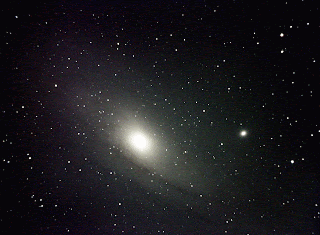Here are 3 pix I took using averaged stacking with the DS16C. I used the f/4 Newt, so there is considerable coma distortion. The M31 pic is an averaged stack of 20 integrations. My research and conversations with people who know stacking suggests that averaged stacking reduces overall noise, but "redistributes" it so that fine details are obscured and contrast is reduced. Compare this averaged stack image (20 integrations) with my previously-posted image of M31. Compared to that image, the noise is lower, but the sky background is quite light even after histogram adjustment. My earlier M31 (posted yesterday), was a much smaller stack using additive stacking. As you can see, there's more detail and a darker sky background, but the overall noise is higher. Unfortunately, I did not capture a single pic, but I suspect it would have shown more detail with a little more noise.
I also captured an image made with a large, averaged stack of the Bubble Nebula. The larger image shows how tiny the nebula is in the very wide field of the scope/imager combo. This image was the result of 70(!) (30+20+20) averaged integrations (the 3 stacked images were combined in Nebulosity). The cropped image shows the faint "bubble" nebulosity. Although the noise is lower than a single image, the single image I used to adjust the integration settings showed the nebulosity with more contrast.
Interesting results.



















